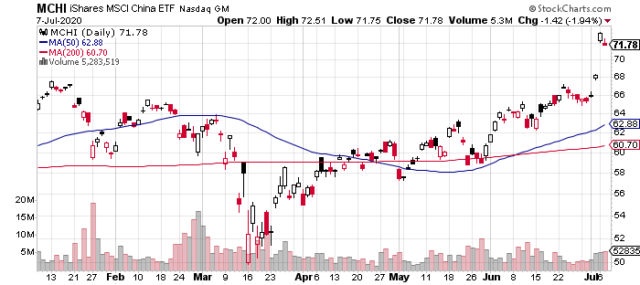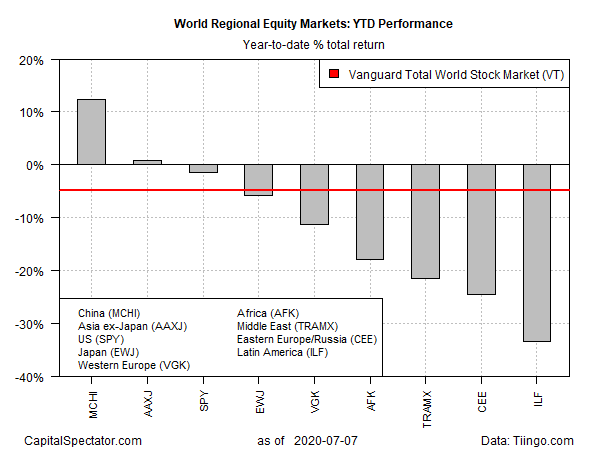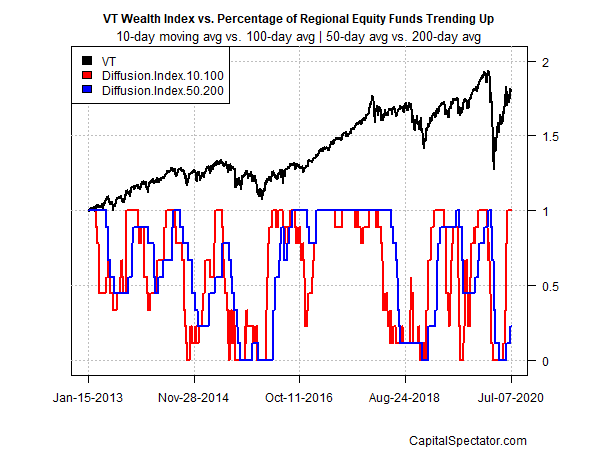China’s stock market is enjoying a banner year in 2020, partly due to a surge in prices in recent days. Using a set of US exchange-listed funds as proxies for the world’s major equity regions also shows that Chinese shares have pulled far ahead of the rest of the field, based on the close of trading for Tuesday, July 7.
The iShares MSCI China ETF (MCHI) is up a strong 12.4% so far in 2020. That’s an eye-popping gain compared with major markets elsewhere in the world.

The global benchmark for stocks is still nursing a moderate year-to-date loss through yesterday’s close. The Vanguard Total World Stock ETF (VT) is down 4.8% in 2020. US equities are doing a bit better, albeit with a softer 1.5% year-to-date loss via the SPDR S&P 500 Trust ETF (SPY).
The steepest loss for our set of regional funds is in Latin America. The iShares Latin America 40 ETF (ILF) remains deep in the red for 2020 with a 33.5% dive.

What accounts for the bullish edge in China’s equities? By some accounts, the key catalyst is the recent improvement in the country’s economic outlook. “China appears to be in better economic shape than other large economies,” according to The Economist.
Because investors must allocate their funds somewhere, there is always a comparative element to market performance. China is the only big economy forecast to grow this year and is still expected to record the strongest rebound next year, according to IMF projections published in late June. There are grave concerns about the toll that the coronavirus might take in America during this autumn’s flu season. But China has shown every intention of smothering renewed outbreaks, giving people and businesses greater certainty about the path ahead.
CNBC, on Monday, reported that China’s government is also a factor by ginning up animal spirits:
A front-page editorial in the state-owned China Securities Journal is getting credit for fueling a strong rally in Chinese markets overnight that spread to global equities. Shanghai stocks jumped 5.7%, after the publication said investors should look forward to the “wealth effect of the capital markets” and the prospect for a “healthy bull market.”
“We have the Fed to juice bull markets, China has its state media,” wrote Peter Boockvar, chief investment strategist at Bleakley Advisory Group.
Skeptics wonder if Beijing is risking another boom-bust episode. Relatively low equity valuations may subdue the threat, optimists say. Another factor that may support an extended bull run: China’s central bank is reportedly taking a more cautious approach to monetary policy.
“It’s very unlikely for us to go through the boom-and-bust like we experienced in 2014 and 2015,” predicts Dai Ming, a fund manager at Hengsheng Asset Management in Shanghai. “The market isn’t flooded with money everywhere like last time. Beijing is still very prudent with its monetary policy.”
Whatever the reason for China’s rally this year, it remains a bullish outlier. For global stocks overall, by contrast, the trend is mixed, based on profiling all the funds listed above through a momentum lens. The profile in the chart below is based on two sets of moving averages. The first measure compares the 10-day average with its 100-day counterpart – a proxy for short-term trending behavior (red line). A second set of moving averages (50 and 200 days) represents an intermediate measure of the trend (blue line). Using data through yesterday’s close reveals that while short-term bullish momentum has rebounded sharply, the medium-term trend has yet to confirm the directional change.

Editor’s Note: The summary bullets for this article were chosen by Seeking Alpha editors.
|
|


Leave a Reply
You must be logged in to post a comment.